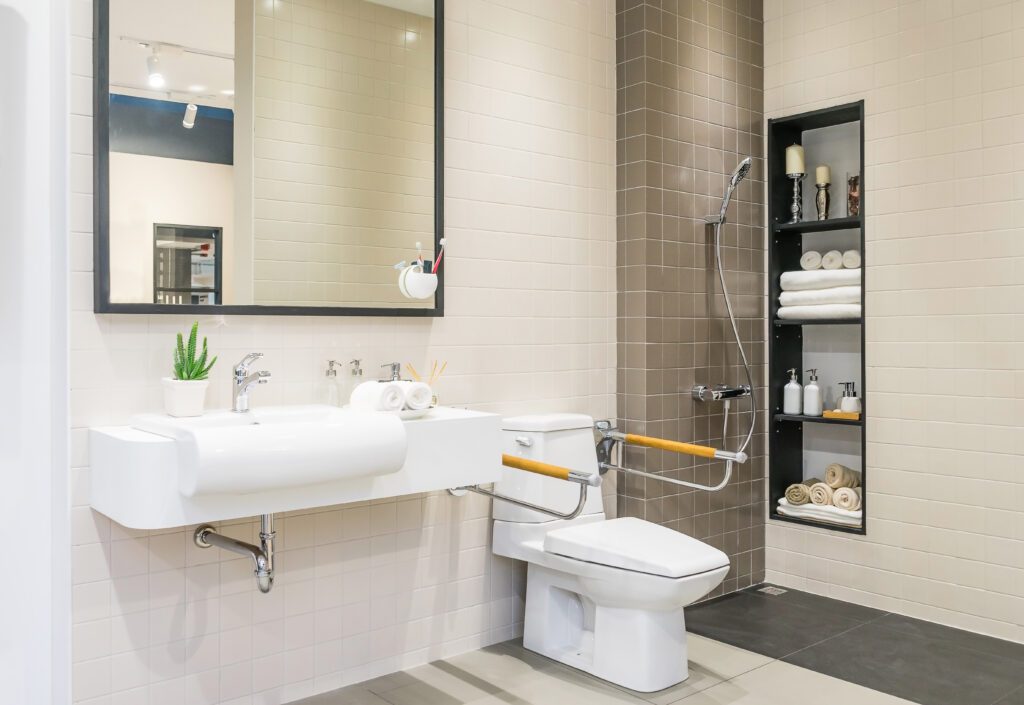The bathroom is one of the most dangerous rooms in the house for seniors. Wet floors, slippery surfaces, and tight spaces can turn even a simple shower into a fall hazard. According to the CDC, more than 235,000 people each year visit emergency rooms for bathroom-related injuries, with seniors accounting for a large share.
As more seniors choose to age in place, bathroom remodeling has become one of the smartest investments in home safety. The right upgrades not only help prevent accidents but also create a comfortable, stylish space seniors can enjoy for years.
We spoke with seniors across the country who remodeled their bathrooms to fit their changing needs. Their experiences show how smart design can make aging in place both safe and beautiful.
“It’s about making smart changes that let us keep living the way we want.”
— Joe, 74, Charleston, SC
A Safer Shower
At 74, Ellen and her husband Joe from Charleston, South Carolina, decided it was time to remodel before an accident forced them to. “Our old shower had a high lip you had to step over. Every time I got in, I worried about slipping,” Ellen says.
They hired a contractor who specialized in aging-in-place design and installed a zero-threshold shower. “Now we can walk right in without worrying,” Joe adds. They also added a built-in bench, handheld showerhead, and anti-slip flooring. “It feels like a spa, but we know it is much safer,” Ellen says.
Zero-threshold showers are one of the most recommended upgrades for accessible bathrooms. The National Institute on Aging reports that most falls at home happen in or near the bathroom, and eliminating tripping hazards like high shower curbs is a proven way to reduce risk.
Making Independence Easier
In Dallas, Texas, 70-year-old Margaret remodeled her master bathroom after her arthritis made bending and twisting painful. “Simple things like turning the faucet or getting off the toilet were becoming harder,” she says.
Her remodel included lever-style faucet handles that are easier on arthritic hands, a comfort-height toilet, grab bars disguised as towel holders, and non-slip porcelain tiles with a matte finish. “I wanted a bathroom that felt like my home, not a hospital,” Margaret explains. “Now it is beautiful and easy for me to use every day.”
These upgrades reflect a growing trend toward universal design, where bathrooms are remodeled to meet changing needs while still feeling modern and attractive.

Making Toilets Safer and Easier to Use
While showers often get the most attention, the toilet is another critical area where simple changes can greatly improve safety and independence.
Rob, 68, from Tampa, Florida, had a stroke last year that affected his balance and mobility. His family quickly realized his standard toilet setup was becoming risky. “He struggled to sit down and get up without help,” says his daughter Melissa. “We didn’t want him to fall and get hurt, so we made a few changes right away.”
They installed a raised toilet seat, added grab bars securely mounted on both sides, and swapped out the bathroom door for one that opens outward, giving more room for a walker. These small adjustments allowed Rob to regain privacy and independence while reducing his risk of falls.
The National Institute on Aging notes that toileting challenges are one of the top reasons seniors require caregiving help. By making these modifications early, seniors like Rob can maintain their dignity and independence longer while aging safely at home.
The Real Costs of Waiting
Many seniors delay bathroom renovations, thinking they are unnecessary or too expensive. But the cost of a fall can be far greater. The National Council on Aging estimates that the average hospital cost for a fall injury is over $35,000.
By comparison, most accessible bathroom remodels range from $8,000 to $25,000 depending on the level of work, according to HomeAdvisor. In many cases, simple modifications like grab bars, non-slip flooring, and upgraded lighting can be done for far less.
More importantly, these upgrades provide daily peace of mind. “I sleep better knowing my bathroom is not a danger zone,” says Joe in Charleston.
Key Bathroom Safety Features to Consider
When remodeling for safety and accessibility, experts recommend focusing on features that work together:
Zero-threshold showers make entering and exiting easier without tripping hazards. Grab bars offer support in showers, near toilets, and along walls where balance may be shaky. Comfort-height toilets reduce strain on knees and hips. Non-slip flooring minimizes slipping when wet. Lever handles on faucets are easier for seniors with arthritis or limited hand strength. Good lighting ensures clear visibility throughout the space. Handheld showerheads provide flexibility whether standing or seated.

Planning Ahead Is Key
The best time to remodel a bathroom for safety is before a crisis happens. “We tell families to think ahead and make these changes early,” says Dr. Laura Simmons, an occupational therapist based in Florida. “Small modifications now can prevent serious injuries later.”
A well-designed, accessible bathroom allows seniors to stay safe, independent, and comfortable in their homes as they age. As Ellen in Charleston says, “It feels good to know we made changes that protect us, but also make our home feel like home.”
About the Author

Bunny, a Maryland native, is enjoying retired life in Charleston, South Carolina, alongside her husband after many fulfilling years as a teacher. She’s a proud mom of two and loves every moment of being Nana to her wonderful grandson.
Sources:




